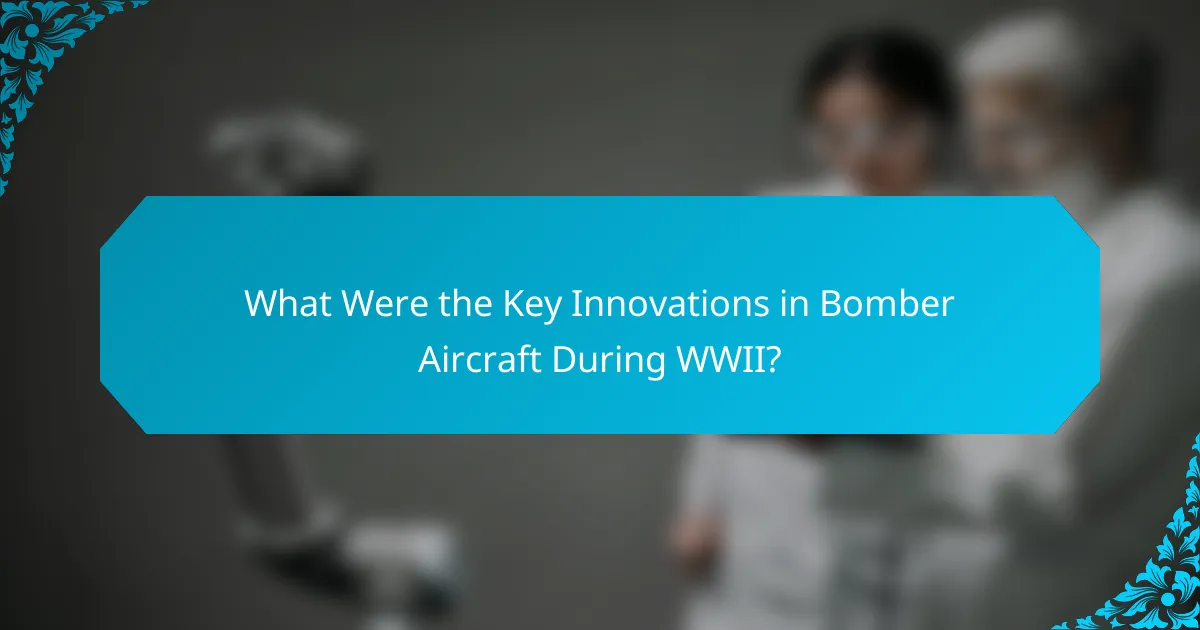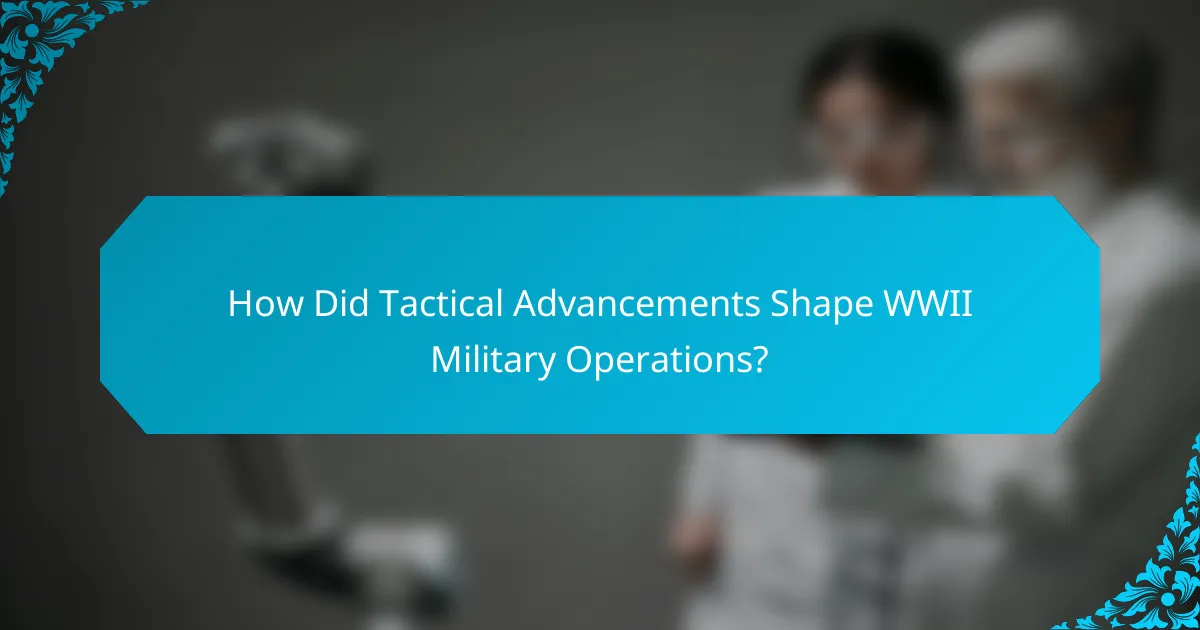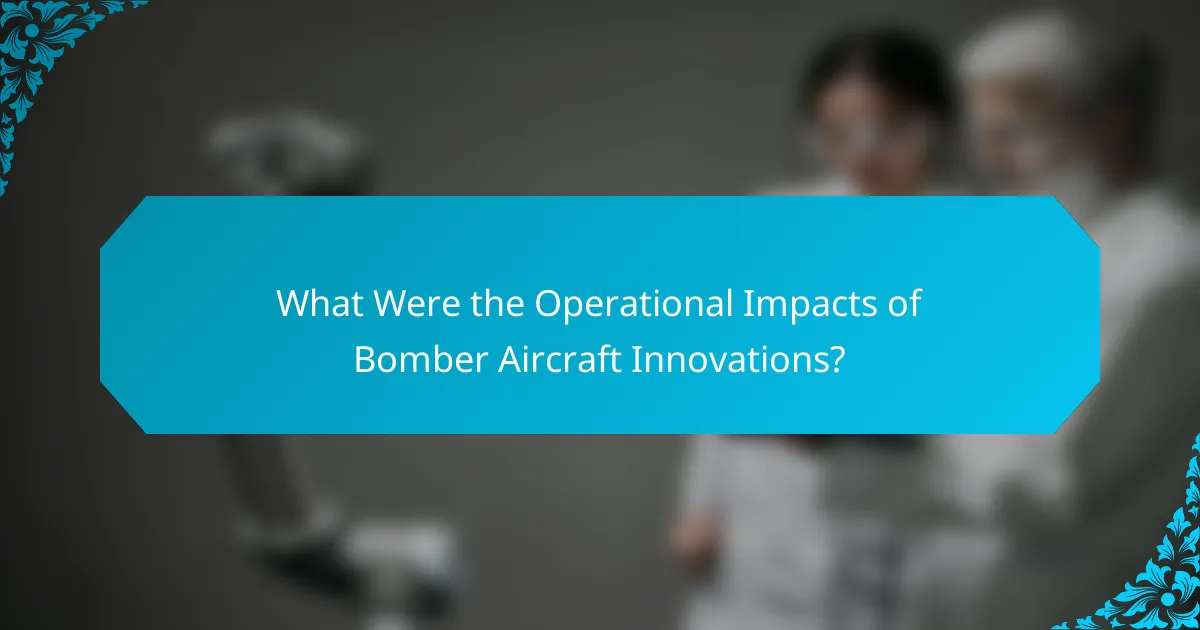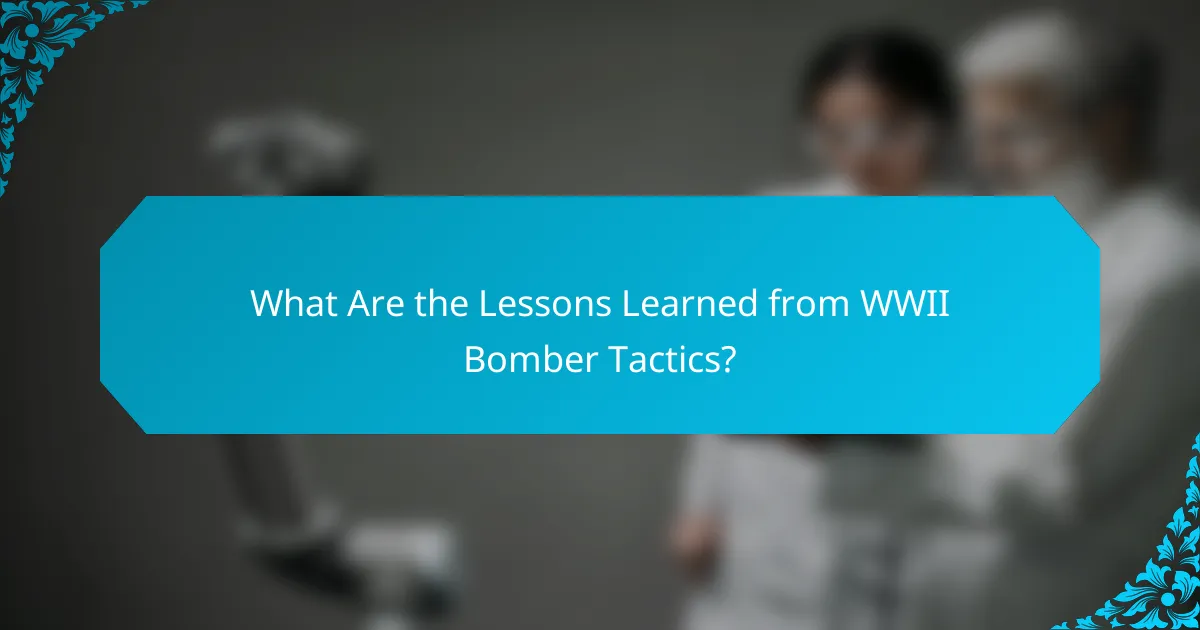During World War II, bomber aircraft innovations played a crucial role in shaping military operations and strategies. Enhancements in aerodynamics, payload capacity, and targeting systems not only improved the effectiveness of strategic bombing campaigns but also influenced enemy morale and military doctrine. These tactical advancements allowed for faster and more coordinated attacks, leading to significant victories on the battlefield.

What Were the Key Innovations in Bomber Aircraft During WWII?
During World War II, bomber aircraft underwent significant innovations that enhanced their effectiveness in warfare. Key advancements included improved aerodynamics, increased payload capacity, and sophisticated targeting systems, which collectively transformed strategic bombing operations.
Boeing B-17 Flying Fortress
The Boeing B-17 Flying Fortress was a pivotal bomber in WWII, known for its durability and defensive armament. It featured a four-engine design that allowed for long-range missions and could carry a substantial bomb load, typically around 4,800 pounds (2,200 kg).
Its innovative design included multiple gun positions for defense against enemy fighters, making it a formidable presence in the skies. The B-17’s ability to sustain heavy damage and still return home earned it a legendary status among bomber crews.
Avro Lancaster
The Avro Lancaster was the Royal Air Force’s primary heavy bomber, renowned for its versatility and payload capacity. It could carry up to 14,000 pounds (6,350 kg) of bombs, including the famous “bouncing bomb” used in the Dambusters raid.
Its design featured a distinctive twin-tail and a spacious bomb bay, allowing for various bomb types and configurations. The Lancaster’s operational success was crucial in night bombing campaigns over Germany, significantly impacting enemy infrastructure.
North American B-25 Mitchell
The North American B-25 Mitchell was a medium bomber that gained fame for its versatility and effectiveness in various roles. It was used extensively in the Pacific Theater, where its twin-engine design allowed for agile maneuvers and low-level bombing runs.
With a bomb capacity of about 3,000 pounds (1,360 kg), the B-25 was well-suited for both strategic and tactical missions. Its success during the Doolittle Raid demonstrated its capability to strike deep into enemy territory, boosting Allied morale.
Technological Advancements in Bombing Systems
Technological innovations in bombing systems during WWII included the development of the Norden bombsight, which significantly improved bombing accuracy. This optical device allowed bombardiers to calculate the optimal release point for bombs, enhancing precision in hitting targets.
Additionally, advancements in radar technology enabled night bombing and adverse weather operations. These systems provided crews with the ability to locate and strike targets with greater efficiency, fundamentally changing bombing tactics.
Impact on Strategic Bombing Campaigns
The innovations in bomber aircraft had a profound impact on strategic bombing campaigns, shifting the focus from tactical engagements to large-scale aerial assaults on enemy infrastructure. The ability to deliver massive bomb loads over long distances allowed for sustained pressure on enemy resources.
Strategic bombing campaigns, such as the Allied bombing of Germany, aimed to cripple industrial production and morale. The effectiveness of these campaigns demonstrated the importance of air superiority and the role of bombers in modern warfare, shaping military strategies for decades to come.

How Did Tactical Advancements Shape WWII Military Operations?
Tactical advancements during WWII significantly influenced military operations by enabling faster, more coordinated attacks and enhancing overall effectiveness. Innovations in strategy and technology allowed forces to adapt quickly to changing battlefield conditions, leading to decisive victories.
Development of Blitzkrieg Tactics
Blitzkrieg, or “lightning war,” was a military strategy that emphasized rapid movement and surprise attacks. This approach combined air support, mechanized infantry, and armored units to penetrate enemy lines quickly and disrupt command structures. The effectiveness of Blitzkrieg was evident in campaigns like the invasion of Poland in 1939 and France in 1940.
Key elements of Blitzkrieg included the use of fast-moving tanks, coordinated air strikes, and effective communication among units. This tactic aimed to create chaos and disorganization within enemy forces, leading to swift victories with minimal casualties.
Role of Air Superiority in Ground Operations
Air superiority was crucial for successful ground operations during WWII, as it allowed for effective reconnaissance, close air support, and the ability to disrupt enemy supply lines. Control of the skies enabled ground forces to maneuver more freely and execute their strategies without the constant threat of aerial attacks.
For instance, the Allied forces’ dominance in the air during the D-Day invasion in 1944 facilitated the successful landing at Normandy. This dominance was achieved through the deployment of advanced aircraft and strategic bombing campaigns that weakened German defenses prior to ground assaults.
Combined Arms Approach
The combined arms approach integrated various military branches—infantry, armor, artillery, and air power—to create a more effective fighting force. This strategy allowed for coordinated attacks that maximized the strengths of each unit while compensating for their weaknesses.
For example, during the Battle of Kursk in 1943, both the Germans and Soviets employed combined arms tactics, utilizing tanks and infantry in conjunction with air support to achieve their objectives. This approach required meticulous planning and communication to ensure all units operated in harmony.
Impact of Deception Tactics
Deception tactics played a vital role in shaping military operations by misleading enemy forces and creating opportunities for surprise attacks. Techniques such as feints, misinformation, and dummy installations were employed to confuse opponents and mask true intentions.
A notable example is Operation Fortitude, which misled the Germans about the location of the D-Day invasion. By creating a fictitious army in England, the Allies were able to divert German resources and attention away from the actual landing site, contributing to the operation’s success.

What Were the Operational Impacts of Bomber Aircraft Innovations?
Bomber aircraft innovations significantly transformed military operations during World War II, enhancing strategic capabilities and altering the course of conflicts. These advancements led to more effective bombing campaigns, influenced enemy morale, and prompted shifts in military doctrine.
Effectiveness in Strategic Bombing
Strategic bombing aimed to destroy an enemy’s war-making capacity by targeting industrial centers, transportation networks, and supply lines. Innovations such as long-range bombers and precision bombing techniques improved the effectiveness of these operations, allowing for greater payloads and more accurate strikes. For instance, the introduction of the Boeing B-17 Flying Fortress and the B-29 Superfortress enabled sustained bombing campaigns over vast distances.
The operational impact was profound, as successful strategic bombing campaigns, like the bombing of German industrial sites, significantly disrupted production and logistics. This contributed to the weakening of enemy forces and ultimately influenced the outcome of battles.
Influence on Enemy Morale
Bomber aircraft not only targeted physical assets but also aimed to undermine enemy morale by instilling fear and uncertainty. The psychological impact of sustained bombing raids on cities, such as the Blitz in London, was substantial, as civilian populations faced constant threats from aerial attacks. This tactic sought to break the will of the enemy and diminish public support for the war effort.
However, the effectiveness of bombing on morale varied. While some populations experienced despair, others demonstrated resilience, rallying around their national identity. The dual nature of bombing campaigns highlighted the complexities of warfare, where psychological factors played a crucial role alongside physical destruction.
Changes in Military Doctrine
The innovations in bomber aircraft led to significant changes in military doctrine, emphasizing the importance of air power in modern warfare. Commanders began to recognize that air superiority was essential for successful ground operations, prompting a shift in strategies that integrated air and ground forces more closely. This led to the development of doctrines that prioritized bombing as a key component of military strategy.
As a result, military planners adopted concepts such as combined arms operations, where air strikes were coordinated with ground assaults to maximize effectiveness. The lessons learned from World War II continue to influence contemporary military strategies, underscoring the lasting impact of bomber aircraft innovations on military thought and operations.

What Criteria Were Used to Evaluate Bomber Aircraft Performance?
Bomber aircraft performance was primarily evaluated based on payload capacity, range and endurance, and defensive armament. These criteria helped determine the effectiveness of bombers in various operational scenarios during World War II.
Payload Capacity
Payload capacity refers to the maximum weight of bombs and munitions that a bomber can carry. This is crucial for mission success, as a higher payload allows for more destructive capability against targets. For instance, heavy bombers like the B-17 Flying Fortress could carry around 4,000 to 8,000 pounds of bombs, significantly impacting their operational effectiveness.
When evaluating payload, consider the trade-off between weight and fuel efficiency. A heavier load may reduce range, so planners often had to balance the desired bomb load with the aircraft’s overall mission profile.
Range and Endurance
Range and endurance measure how far a bomber can fly and how long it can stay airborne. These factors are essential for reaching distant targets and returning safely. Many bombers had operational ranges between 1,000 to 3,000 miles, allowing them to strike deep into enemy territory.
Endurance is influenced by fuel capacity and consumption rates. For example, bombers designed for long missions often had larger fuel tanks, but this could compromise payload capacity. Understanding the mission requirements helps in selecting the appropriate aircraft for specific operations.
Defensive Armament
Defensive armament includes the weapons systems installed on a bomber to protect it from enemy fighters and anti-aircraft fire. Effective defensive armament can significantly enhance a bomber’s survivability. Many World War II bombers were equipped with multiple machine guns, with some models featuring up to 13 gun positions.
When assessing defensive capabilities, consider the aircraft’s speed and maneuverability, as these factors also play a role in evading attacks. A well-armed bomber that is slow or difficult to maneuver may still be vulnerable. Therefore, a balanced approach to armament, speed, and agility is essential for operational success.

What Are the Lessons Learned from WWII Bomber Tactics?
World War II bomber tactics taught military strategists valuable lessons about air power, precision, and the importance of coordination. Key takeaways include the effectiveness of strategic bombing campaigns, the need for advanced technology, and the impact of intelligence on operational success.
Strategic Bombing Campaigns
Strategic bombing campaigns aimed to destroy an enemy’s war-making capabilities by targeting industrial centers, transportation networks, and morale. The effectiveness of these campaigns varied; while they significantly disrupted production, they also often resulted in high civilian casualties and backlash. Understanding the balance between military objectives and humanitarian considerations became crucial.
For example, the Allied bombing of German cities like Dresden demonstrated the devastating impact of strategic bombing but also raised ethical questions about civilian safety. Military planners learned to weigh the potential military gains against the broader consequences of their actions.
Technological Advancements
Technological innovations during WWII, such as the development of long-range bombers and precision-guided munitions, transformed air warfare. Aircraft like the B-29 Superfortress showcased the importance of range and payload capacity, allowing for deeper strikes into enemy territory. These advancements highlighted the necessity for continuous investment in military technology.
Moreover, the introduction of radar and improved navigation systems enhanced bombing accuracy and operational effectiveness. Future military strategies would need to incorporate these technologies to maintain an edge in aerial combat.
Coordination and Intelligence
Effective coordination between air and ground forces was essential for successful bombing operations. The integration of intelligence gathering and reconnaissance allowed for better-targeted strikes and minimized collateral damage. Lessons learned emphasized the importance of real-time information and communication among units.
For instance, the use of aerial reconnaissance to assess damage and adjust tactics in subsequent missions proved vital. Military operations in the future would benefit from establishing robust intelligence frameworks to support air campaigns.



